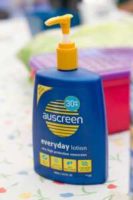22 May EWG Urges Sunscreen Companies and Consumers To Go Oxybenzone-Free By 2020
MedicalResearch.com Interview with:
 Carla Burns, M.S.
Carla Burns, M.S.
Environmental Working Group
She is one of the coauthors of the 2018 Guide to Sunscreens.
MedicalResearch.com: What is the background for the EWG report?
Response: Environmental Working Group (EWG) published its first Sunscreen Guide in 2007.
When we first started the guide, many sun protection products sold in the U.S. were not as safe and used misleading marketing claims.
Throughout the years, EWG has continued to find that a common sunscreen ingredient, oxybenzone, poses a hazard to human health and the environment. Despite EWG’s efforts to draw attention to the health hazards associated with this ingredient over the last 12, oxybenzone remains widely used in chemical-based sunscreens. So, this year, we are ramping up our efforts to rid the market of this ingredient by launching a campaign to urge companies and consumers to go oxybenzone-free by 2020.
MedicalResearch.com: What are the main benefits of sunscreens?
Response: A good sunscreen protects against the sun’s harmful UVA and UVB rays, which have both been linked to skin cancer. Unfortunately, many of the sunscreens currently on the U.S. market can help prevent sunburn (which is caused mostly by UVB rays) when used appropriately, but many products don’t offer strong enough UVA protection.
Preventing sunburn and reducing UV exposure is critical to lowering risks of developing serious forms of skin cancer. To be best protected, sunscreen should be used along with other sun protection measures, like wearing a hat and t-shirt, avoiding midday sun, and staying in the shade.
MedicalResearch.com: Why is sun protection important?
Response: Sun protection is important at all ages, but it is particularly important for children.
Getting severe sunburns as a child can double a person’s lifetime chances of developing serious forms of skin cancer. Sun protection is more than just applying sunscreen. It is equally important to include additional measures such as wearing sunglasses, wearing a t-shirt and hat, staying in the shade, and avoiding midday sun.
MedicalResearch.com: What are the potential harmful effects of sunscreens, either to people or the environment?
Response: Some ingredients in sunscreens have been linked to a myriad of human and environmental concerns. For example,oxybenzone, a widely used active ingredient, is a skin sensitizer and hormone disruptor that is harmful to both children and adults. It has also been linked to coral bleaching and coral death. This year, EWG is ramping up our efforts to rid the market of this ingredient by launching a campaign to urge companies and consumers to go oxybenzone-free by 2020.
MedicalResearch.com: What types of sunscreens are less harmful?
Response: EWG recommends that people choose mineral-based products with zinc oxide or titanium dioxide active ingredients. These products contain active ingredients that provide adequate sun protection with fewer health concerns compared to many chemical-based sunscreens. In addition, choose a lotion or stick over sprays, to avoid inhalation concerns, and always choose products between SPF 15 and 50.
MedicalResearch.com: Are there ingredients you suggest the public use or avoid?
Response: Our advice to consumers is to opt for mineral-based products with zinc oxide or titanium dioxide active ingredients and to avoid products with hazardous ingredients like oxybenzone, an endocrine disrupting chemical, and retinyl palmitate, which may speed the growth of skin tumors and lesions on sun exposed skin.
MedicalResearch.com: Is there anything else you would like to add? Any disclosures?
Response: EWG assessed more than 1,000 SPF products on market and found that the majority of sunscreens still do not meet EWG’s standards for safety and efficacy. About 67 percent of the products offer inferior sun protection or contain worrisome ingredients.
MedicalResearch.com: Thank you for your contribution to the MedicalResearch.com community.
Note: Content is Not intended as medical advice. Please consult your health care provider regarding your specific medical condition and questions.
[wysija_form id=”1″]
Last Updated on May 22, 2018 by Marie Benz MD FAAD
